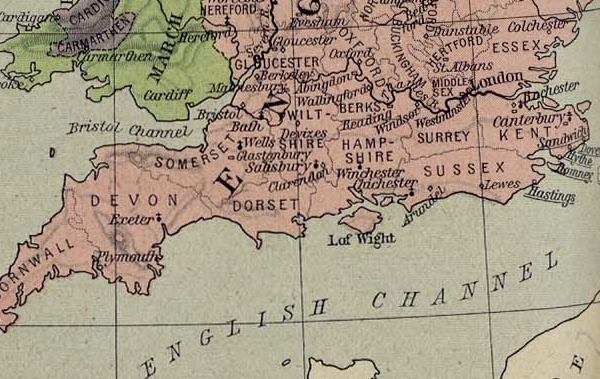
“Of Considerable Antiquity”
In the book A Genealogy of the Kidder Family by Morgan Hewitt Stafford [1941], Stafford writes that there is ample evidence available to prove quite conclusively that the Kidder family lived in Sussex England more than six hundred years ago, when certain of the name are to be found as landowners in the time of Edward II (1307-1327). The Subsidy Roll for 1332 for Sussex, 6 Edward III, carries the name of ‘Simon at Hole’ as Simon Kydder was then known by reason of his residing in a deep forest glen within the borders of Lancaster Great Park-a large section of Ashdown Forest enclosed by John of Gaunt as a royal preserve.
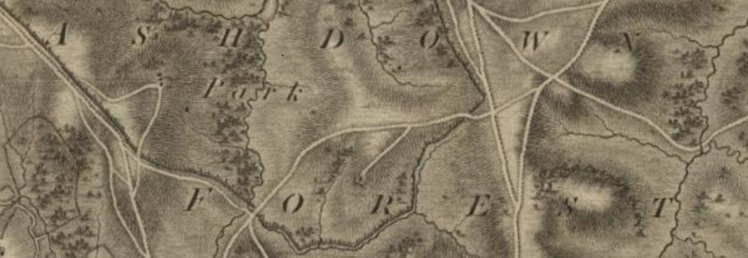
Here Simon served as ‘Bayliffe,’ a Crown office which gave him the superintendence of the forest and of its subordinate officers under the verderer, and it is believed that subsequent heads of the Kidder family became the hereditary possessors of this coveted position of honor and profit.
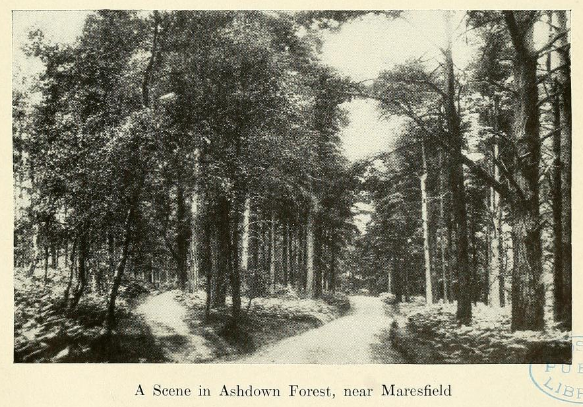
The ancient residence of the family at the ‘Hole,’ or the ‘Pool,’ as it was sometimes called because of its close proximity to a small body of water, was a stone structure of moderate size of which only the foundation now remains to indicate its site, and it is supposed that much of the adjoining property was a part of the Kidder patrimonial estate.
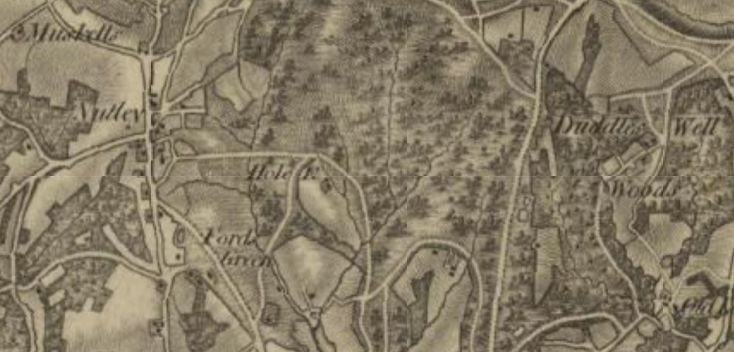
Lancaster Great Park lay partly within the borders of the parish of Maresfield in Sussex, and there the family rose from a condition of comparative obscurity to one of considerable prominence.
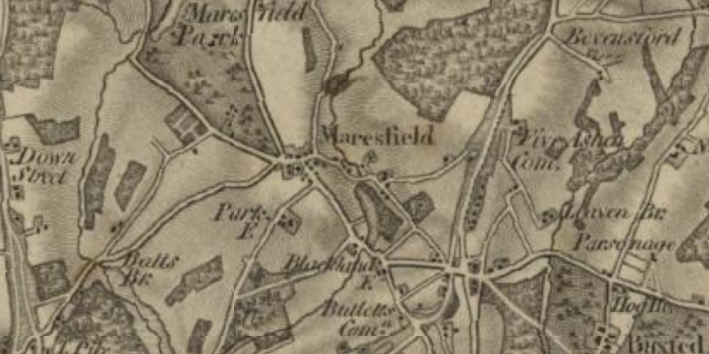
As respectable yeomen they served at sundry times as overseers of the poor and as church wardens. Occasionally they were to be found serving as sponsors for the children of some of the leading gentry of the community. The register books of Maresfield, which date from the year 1538, contain among their earliest entries events with which the Kidders were connected, and from then on the name appears frequently in the parish and other records.
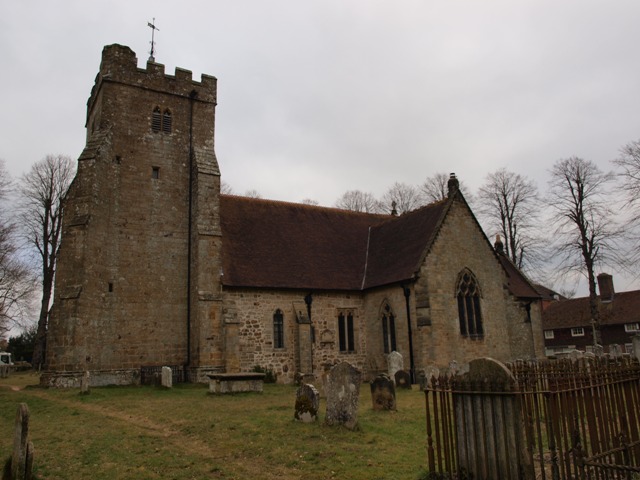
In a sketch of the Kidder Family in his History of New Ipswich (New Hampshire), Frederick Kidder states (presumably on the authority of Rev. Edward Turner, well known antiquarian of Sussex, with whom he was in correspondence for many years) that ‘previous to the year 1500 all of the name Kidder, who were then on earth, were residents in Maresfield, but soon thereafter there seems to have commenced a gradual migration on the part of members of the family to nearby towns and counties, and to London. Among them was a Kidder who settled at Canterbury, in Kent, where he died in 1543 leaving a sizable estate to his children, certain of whom are referred to as tradesmen of that city. Some years later George Kidder, grandson of Thomas of Maresfield, took up his abode in London and became founder of a branch there and in Ireland through his son Vincent…A Gilbert Kidder was another settler in London, where he married and left descendants. Late in the sixteenth century Thomas and Richard removed to the adjoining parish of East Grinsted and were followed probably about the year 1599 by John Kidder, grandfather of James, the emigrant to New England.
James Kidder II (1626-1676)

James Kidder II was born at East Grinsted in Sussex, England, in 1626 to James Kidder (1595-1684) and Elizabeth (Betsey) Bartlett (1599–1639). In 1852 it was suggested by Frederic Kidder, author of The History of New Ipswich, that James Kidder II was the ancestor of all who bear the Kidder name in the United States.
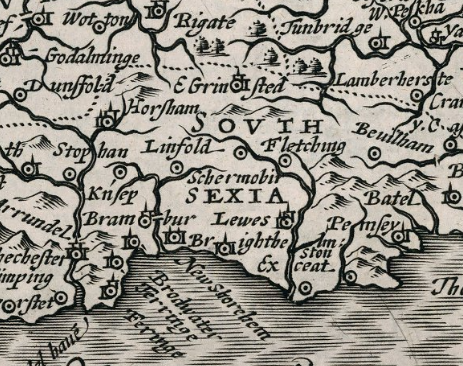
The year that James Kidder made his trip to New England is not (yet) known, but it’s assumed it was just prior to 1649. His name first appears on record in Cambridge, Massachusetts in 1649 when he married Anna Moore (Hannah)(1630-1691), daughter of Elder Francis Moore and Katherine Cooper Monford.
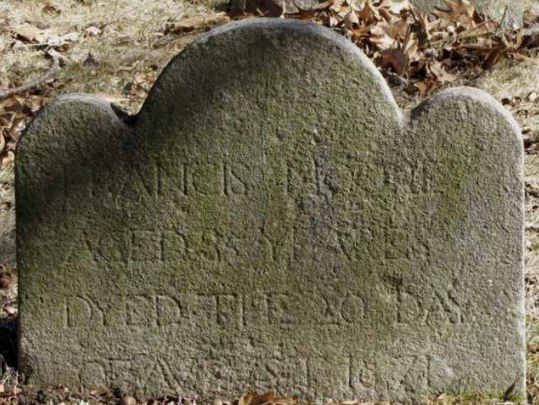
In 1653 James worked a farm of two hundred and eighty-nine acres, located on the north side of Fresh Pond and Monotony River [aka Alewife Brook], which he had leased from Deacon Nathaniel Sparrowhawke.
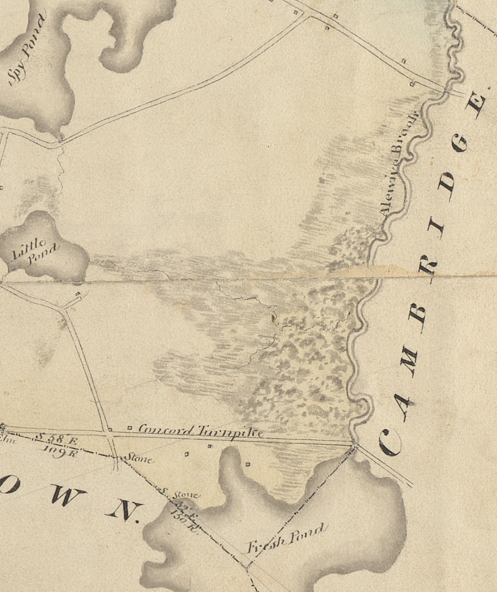
In 1653 the General Court granted Billerica (formerly called Shawshin) to Cambridge. Many of the older Cambridge residents received Billerica land grants. James Kidder was among the first to move his family there in 1656.
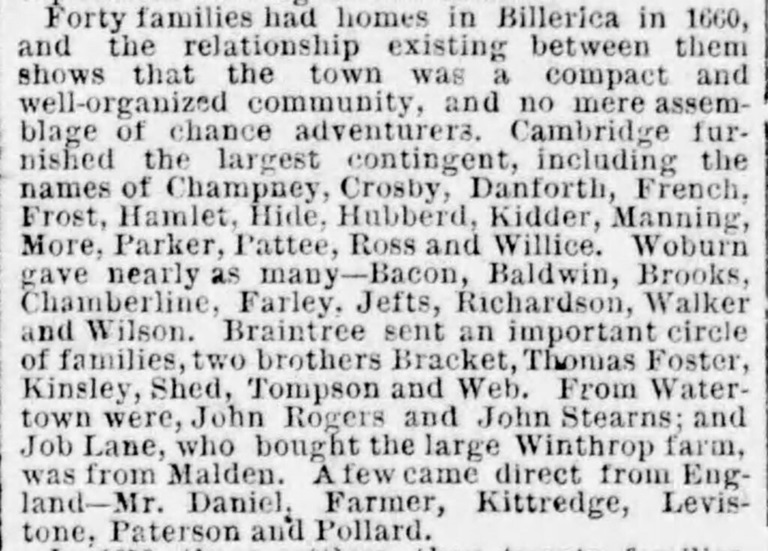
James Kidder received a grant of a ten acre lot in Billerica, but it was not located until 1658. He didn’t occupy it until 1659. The ten acre lot may have been expanded as his home was later noted on thirty acres of land located near the center of the township. “It was bounded by John Rogers property on the south, common land on the east, the West street or highway which leads from long street to the great river on the north, and by the great river on the west.”
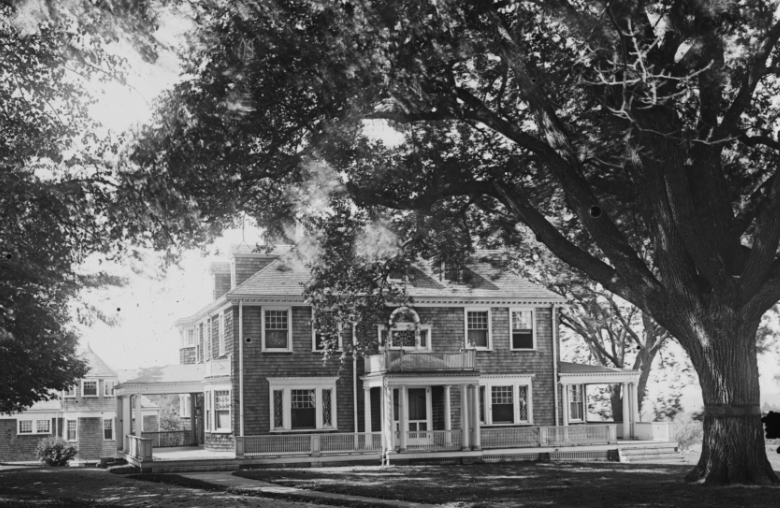
The Kidder homestead covered the southwest corner of River Street and Concord Road. 16 River Street is the location of the former Kidder home. Kidder’s large home was one of twelve in Billerica used during King Philips War as a garrison in 1675 for the protection of colony inhabitants. Three families found refuge there, among the Kidder family. These were the families of Daniel Shed Jr, Samuel Trull, and John Bracket. The Jonathan Danforth homestead was across River Street on the northwest corner of River Street and Concord Road.
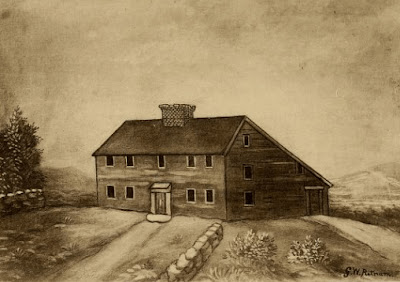
Billerica continued to be the home of the James Kidder family for over one hundred years. The Kidder family started attending church at the meeting house in Billerica in 1663. Samuel Whiting was minister.
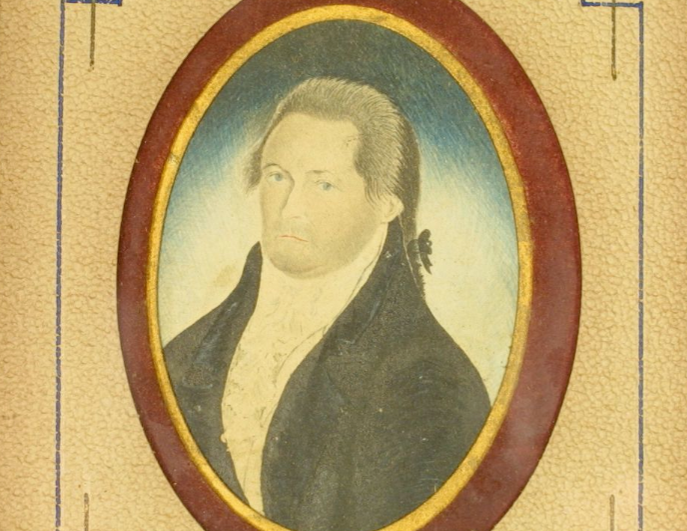
The meeting house was a forty foot square structure with a thatched roof that had been built in 1659. It was later replaced.
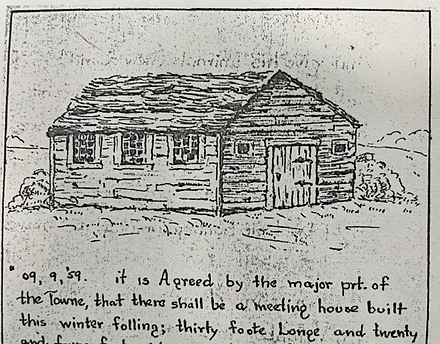
The Kidder homestead became the Parker homestead in 1751 after Abigail Kidder (daughter of Enoch) married John Parker. It was later the homestead of Stephen Parker and then his son Gardner Parker and then J. Nelson Parker. Stephen Parker stated that his grandfather John Parker had planted the “John Parker Elms” in front of J. Nelson Parker’s place about 1750. James Kidder also owned twenty-six acres on the plain beyond Loes Meadow, sixty acres south-east of Fox Hill, Thirty-one acres at the head of Heath Brook (now in Tewksbury) and other smaller lots.
“I think my great-grandfather was killed by the Indians.”
– Samuel Kidder 1734-1776 (Great-Grandson of James Kidder)
In 1662, James was a juror of the General Court, holden in Cambridge. Court records of that year note, “James Kidder is allowed to be sergeant of the Military Company at Billerica.” By 1675 James was Ensign in Capt. Jonathan Danforth’s Military Company and his house was used as a garrison during King Philip’s War. On April 16, 1676 there was some “fighting on a hill near Kidder’s garrison where four or five were killed or wounded.” James was one those killed. His burial site is unknown.
Billerica, MA: South Burying Ground
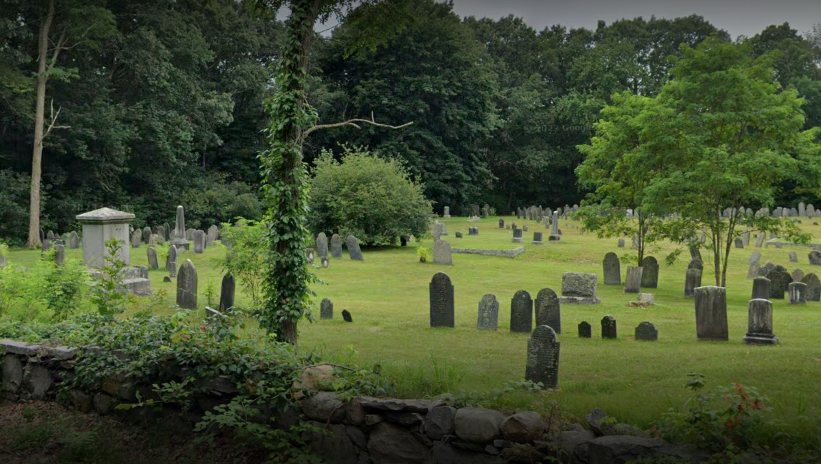
The South Burying Ground was given to the Town of Billerica in April 1663 by Ralph Hill, Sr.; the half-acre lot was the first established cemetery in town. Ralph Hill Sr. died just a few days after this donation and it is assumed he was the first to be buried here although there is no marker standing to confirm this. Many of Billerica’s most prominent first settlers are buried here. The South Burying Ground is located at the junction of Concord Road and French Street. Perhaps James Kidder II is buried there. Anna later remarried.
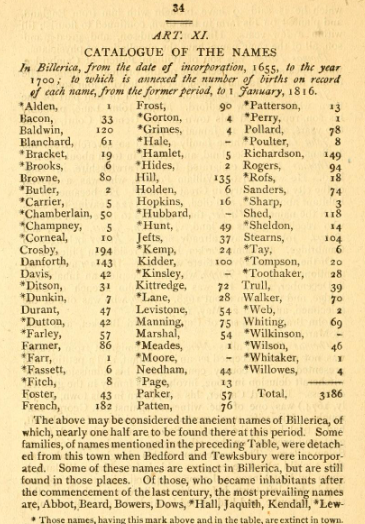
James Kidder III (1653–1732) and Elizabeth Brown (1659-1691)
Born: Cambridge, Massachusetts January 3, 1653/4; Lived in and died in Billerica, December 15, 1732. Married Elizabeth Brown at Billerica, September 23, 1677 /8. Elizabeth Brown was born May 5, 1659; died at Billerica, August 1691, daughter of William and Elizabeth (Ruggles) Brown. Her brother George married Sarah Kidder, sister of James.
James Kidder IV (1679–1729) and Mary Abbott (1686–1743)
Born at Billerica, Mass., 27 June 1679; died at Mansfield, Conn., 18 May 1729. He married at Concord, Mass., 8 Nov. 1703, MARY ABBOTT of that town, born at Andover, Mass., 23 July 1686, daughter of Capt. Thomas and Sarah (Steward) Abbott. James Kidder settled in Mansfield, Conn. about 1703, the year of its incorporation as a town, and thus became one of its earliest inhabitants. He purchased twenty-five or thirty acres of land there in 1709. His will, dated 22 Mar. 1729, in which he describes himself as “Husband man,” “sick and weak in body,” provides for the appointment, as sole executor, of his son James to whom he devises “all my lands in Mansfield” and other property. To his wife Mary, he bequeaths certain specified items, and “all my movable estate and one third rooms, & c.”
Ephraim Kidder (1716–1796) and Freedom Barnard (1715–1788)
Born at Mansfield, Conn., He married at Coventry, Tolland Co., Conn., 26 Dec. 1738, FREEDOM BARNARD of that place, born there 1715/16, daughter of Benoni and Freedom Barnard. Ephraim Kidder resided in Coventry until about 1750, when he and his family disappear from the records of the town. A deed recorded 19 Apr. 1753, describes him as of Nine Partners, Dutchess Co., N. Y., where his son Ephraim, Jr. is said to have been born, and perhaps the latter’s two younger brothers, John and Stephen. Family records indicate that certain of his sons lived at New Marlboro, Berkshire Co., Mass.
Ephraim Kidder II (1754–1836) and Sarah Spencer (1763–1821)
Ephraim Kidder was born at Nine Partners, New York. He married Sarah Spencer from Columbia Co., New York. Ephraim Kidder went to Benton, Yates Co., N. Y., from Spencertown, Columbia Co., N. Y., about 1800. Family accounts say that 16 of his 17 children were born there. He served in the Revolutionary War, enlisting at Spencertown, and was engaged in the Battle of Stillwater.
Cyrus Phillip Kidder (1799–1879) and Maria Rebecca Waldron (1800–1858)
Of Benton Township, Yates Co., N. Y., born at Spencertown, Columbia Co., N. Y. in 1799, said to have died in Tennessee. He married MARIA WALDRON, died in Benton Township about 1858.
Wellington Edward Kidder (1823–1906) and Mary Anne Mellen (1829–1883)
WELLINGTON EDWARD7 KIDDER (Cyrus Philip6, Ephrairn5, Ephraim4, James 3, James2, James1) a school teacher of Irving and Hastings, Michigan, born at Benton, N. Y., 29 Aug. 1820; died at Irving, Mich., 17 or 27 Apr. 1906. He married first, in r,.fichigan, M:ARY ANNE MALONE, born at sea, died at Irving, Mich., daughter of Philip and Aurora (Best) Malone; and secondly, at Hastings, Mich., in 1885, EMMA JANE KEECH or KucH.
William Edwin Kidder (1850–1923) and Lydia Maria Keech (1866–1955)
WILLIAM8 KIDDER (Wellington Edward7, Cyrus Phillip6, Ephraim 5, Ephraim\ James3, James 2, James 1 ), probably born in Michigan; married LYDIA KEECH.
Warren Albert Kidder (1884–1949) and Nellie A Tewksbury (1886–1928)
Lenna Belle Kidder 1904-1980 (Maternal Great Grandmother)
RESOURCES
A History of the Kidder Family from A.D. 1320 to 1676 Including a Biography of Our Emigrant Ancestor, James Kidder, Also a Genealogy of His Descendants Through His Son, John Kidder, who Settled in Chelmsford, Mass., about 1681 By Frank Eugene Kidder · 1886
A Genealogy of the Kidder Family Comprising the Descendants in the Male Line of Ensign James Kidder, 1626-1676: Of Cambridge and Billerica in the Colony of Massachusetts Bay by Morgan Hewitt Stafford (1941)
The History of New Ipswich From Its First Grant in MDCCXXXVI, to the Present Time: with Genealogical Notices of the Principal Families, and Also the Proceedings of the Centennial Celebration, September 11, 1850 By Frederic Kidder, Augustus Addison Gould · 1852
New England Families, Genealogical and Memorial A Record of the Achievements of Her People in the Making of Commonwealths and the Founding of a Nation · Volume 2 1913, Kidder p519
The New England Historical and Genealogical Register Volume 41 1887 p.137
Sketch of the Life of Frederic Kidder By John Ward Dean · 1887
Sussex Archaeological Collections Relating to the History and Antiquities of the County Volume 9 By Sussex Archaeological Society · 1857
